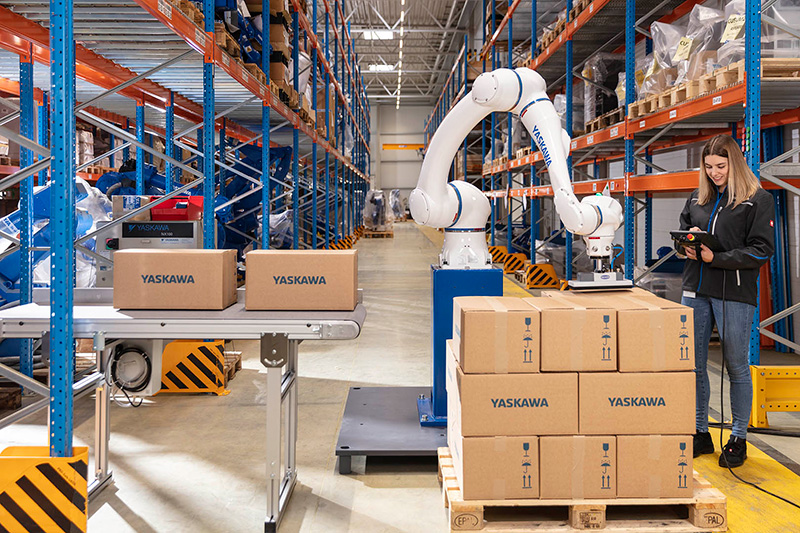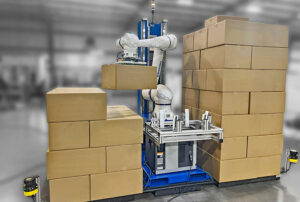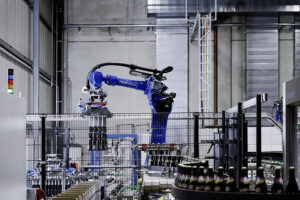Adapting to Dynamic Change

Highly intuitive tablet-based touchscreen teach pendants are enabling operators of all experience levels to more easily and rapidly program robots. Image courtesy of Yaskawa America Inc.
Robotic Automation for Greater Packaging Productivity
By Chris Caldwell, Product Manager at Yaskawa America Inc. – Motoman Robotics Division
The quest to optimize equipment efficiency, ensure consistent quality and lower operational costs while empowering a stronger workforce continues to permeate the industrial landscape. While challenges persist, the transformative potential high-performance robotic automation is bringing to packaging processes is undeniable, creating a new era of manufacturing and logistics.
Once a novelty, packaging robots for pick and place, packing, palletizing and more are now a staple for maintaining fluid workflow for supply chain resiliency. Especially true for the e-commerce, food and beverage and pharmaceutical sectors; the adoption of robust yet flexible packaging robots and their intelligent peripherals is expected to grow at a compound annual growth rate (CAGR) of 10% by 2032 according to a recent report by Global Newswire.
As this next frontier of packaging productivity continues to grow, more and more companies will adapt to dynamic change through technology adoption, including collaborative automation, easy programming, motion control, tooling advancements, enhanced vision technology and artificial intelligence (AI), Internet of Things (IoT) connectivity and energy efficiency.

Using robots for applications such as palletizing was once considered a novelty but is now a staple for meeting the needs of an ever-changing workflow. Image courtesy of BMG.
Collaborative automation
Today, the evolution of safety standards and easy programming methods combine with space-saving, user-friendly robot designs to boost automation confidence. Decision makers once locked into fixed automation layouts with task-specific machinery are now able to integrate flexible solutions to better manage the influx in consumer product variety.
Longer arm collaborative robots with power and force limiting (PFL) technology are especially beneficial for working alongside human workers to complete highly repetitive tasks such as case erection, labeling, packaging, pick and place and quality control. Likewise, IP67 washdown ratings and easy-to-clean surfaces on select cobots make them an ideal choice for use in sanitary settings or harsh environments, while options with NSF H1 food-grade grease are suitable for use in spaces where there is the possibility of incidental food contact. For packaging and parcel ground shipping, high-speed heavier payload capacity (i.e., 20-30 kg) collaborative robots are ideal for processing common case weights, handling a wider variety of packages for improved cycle times.
Easy programming
Along with hand-guiding, intuitive tablet-based teach pendants with leading human machine interfaces (HMIs) facilitate easy programming capability, enabling users to guide a robot with familiar commands via a “click and program” approach. Moreover, graphical user interface (GUI) pendants simplify programming and create more accurate path planning for safer production. From making the robot operator the frame of reference and eliminating the use of conventional coordinate (X, Y, Z) frames, to providing descriptive commands for touch-to-edit job capability; GUI pendants greatly reduce the robot learning curve for fast changeover and quick implementation of a robot system.
Motion control
Additionally, the ability to control every component in a given network is now easily manageable. This is especially true for material handling applications. Whether an automated system is designed for a single job or a combination of tasks, the use of programmable logic controllers (PLCs) or motion control gives robot operators a user-friendly approach to automation implementation where robots can be added to existing automation without requiring a separate programming language. For example, companies can seamlessly integrate high-performance robots into current conveyor systems to optimize material flow and packaging speed. Conveyor systems and robots utilizing the same industrial drive technology often provide a competitive edge to companies, offering complete control for easier integration and conveyor tracking support.
Tooling advancements
To meet more diverse task requirements for a wider user group, industrial and collaborative robots are being fitted with more advanced, powerful and flexible end-of-arm tooling (EOAT) to process higher case payloads and movement speeds for optimal throughput. Likewise, a wider variety of packaging materials and shapes are also accommodated for greater productivity. To facilitate the higher duty cycles required for some applications, a growing number of vendors now offer standard external dress packs to support more robust EOAT.

Safe and reliable robot-based handling with sophisticated Air Grip technology optimizes throughput for greater productivity. Image courtesy of Yaskawa America Inc.
Enhanced vision and AI
Extremely helpful to reaching aggressive throughput targets, enhanced vision capability continues to improve the speed for acquisition and recognition of objects, especially for extremely unstructured environments where there is limited knowledge of object size, shape or orientation. From upstream induction to trailer loading, feature-rich 3D hardware/software solutions are integral for accurately and efficiently completing many packaging line tasks.
Sophisticated vision and sensor technology combined with advances in AI and machine learning algorithms are also revolutionizing operations. Solutions with proprietary perception tools, like those from Mujin and Covariant, use AI-driven data from simulation processes to effectively teach robots realistic path programming. This ability to fill the simulation-to-reality (Sim2Real) gap is invaluable to robot performance, and it is equipping these virtual workhorses with impressive handling capabilities.
IIoT connectivity
To create value at scale, organizations are selectively implementing a myriad of advanced technologies to cultivate highly productive workspaces. Along with this, the digital data available from qualifying devices is being harnessed by open platform communication unified architecture (OPC-UA) platforms for real-time remote monitoring of an entire extended enterprise. From collecting individual robot data to tracking radio frequency identification (RFID) tags, manufacturing supervisors and warehouse managers can see what is happening at any point on the value creation chain to gain actionable insights for overall equipment effectiveness (OEE), product quality and order accuracy.
Energy efficiency
Where energy efficiency is concerned, a growing number of robot designs are becoming more energy-efficient to reduce operational costs and environmental impact. Highly attractive to companies with sustainability goals, robotic arms with regenerative braking standards are being implemented to support energy initiatives.
Dynamic operations for future success
As consumers necessitate faster, more accurate order fulfillment with zero-error delivery, the ability for companies to maintain fluid parcel flow will make or break their operations. For this reason, decision makers must be cognizant of the tools required to bolster current workforces and meet pressing demands. Moving forward, conventional packaging processes will continue to give way to more dynamic production environments where intelligent technologies will help drive competitive advantage.
About the Author
Chris Caldwell is Product Manager at Yaskawa America Inc. – Motoman Robotics Division. Learn more at www.motoman.com.







